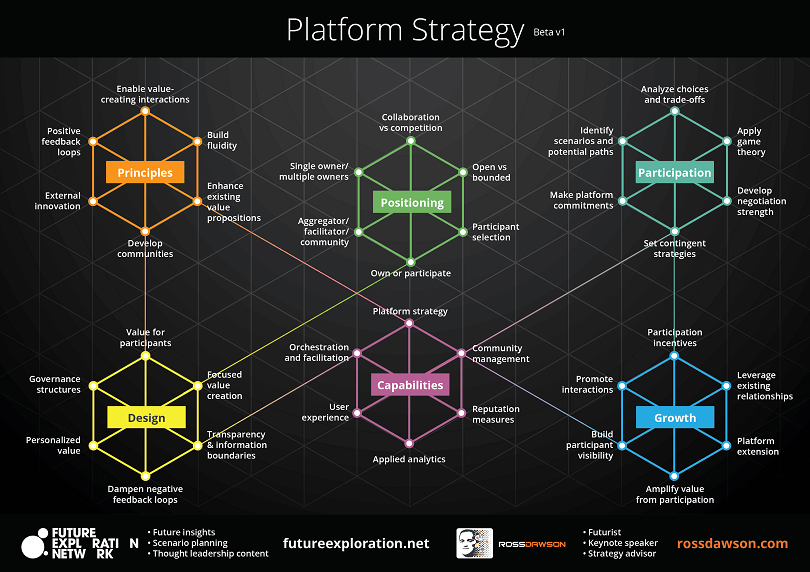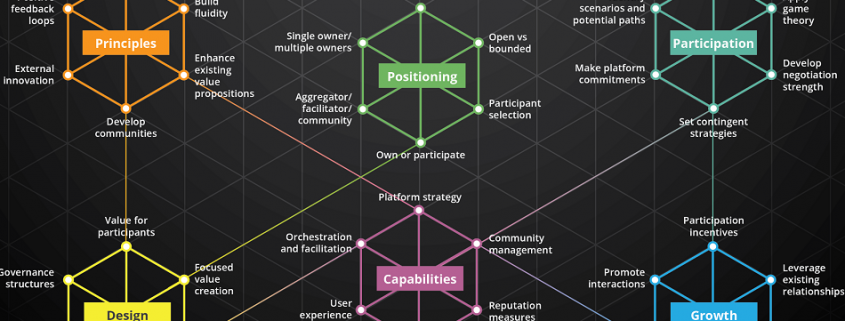New framework: The six elements of Platform Strategy
Tomorrow I am giving the keynote on Platform Strategy: Creating Exponential Value in Connected Times at the Digital Single Market Cloud Stakeholder Conference in Vienna, Austria.
An increasing proportion of my work over the last years has been explicitly centered on platforms and platform strategy, but in many ways it is has been core to my work for almost two decades.
After working on financial market platform strategy for major banks around 2000, my 2002 book Living Networks delved into the emerging network economy built on standards and the early platforms it was enabling. My work over the last decade and more around social networks, future of media, crowdsourcing, future of work, enterprise technology, and strategy for emerging technologies such as AI, IoT and blockchain among other themes has all related to platforms.
Today platforms are intensely relevant in almost every domain, including not just obvious industries such as technology, media, and financial services, but also many others including health, education, government, infrastructure, democracy, and far more.

Click on the image for full-size pdf
To summarize and consolidate some of my thinking around platform strategy I have created a visual framework of some the major facets of strategy for platforms, which I am sharing for the first time in public at tomorrow’s conference.
Down the track I will share a more detailed description of the framework and create deeper content on platform strategy, as this framework is an extremely condensed overview of the major strategic issues.
For now here is a brief overview and explanation of the six major themes of platform strategy. You can also see an overview of my keynotes on Platform Strategy here.
Principles
Platforms shift the traditional model of value creation from inside organizations to enabling external value-creation from an extended ecosystem of participants. Positive feedback loops are intrinsic to platforms, most evidently in increasing numbers of participants expanding value and thus drawing in more participants from linked markets. To build value requires enabling more fluid interactions, as Instagram did by building in image filters and initially piggybacking off Facebook. The most effective platform are often true communities rather than pools of users, who drive innovation in the platform through their participation and input.
Positioning
There are a range of critical decisions to make in positioning a platform. These include where you collaborate and where you compete, single or multiple owners, whether it is open to all participants or bounded, and the selection criteria for participants. Expert platforms such as Expert360, 10EQS and Catalant have stringent requirements for their service providers to ensure quality and trust. Strategically one of the most critical decisions is whether to build your own platform, or to participate in existing platforms. Of course the answer could be both, depending on the domain and in order to compete effectively.
Participation
It is not always viable to compete by building your own platform. In some industries it is almost essential to participate in established, dominant platforms, in which case you need to have a clear strategy for your platform participation. This starts from clear analysis of the choices you have in order to make choices and where needed commitments. Game theory can be valuable in analyzing potential scenarios for how the platforms can play out and to set contingent strategies, for example if platform owners change the rules of the game. When Facebook Instant Articles launched I told news publishers how they needed to go in eyes wide open, which was later borne out. There are also ways to shape dominant platforms, sometimes through collective action from participants.
Design
There are a range of fundamental issues in designing successful platforms. At the heart is being clear on what value is created for the participants from their perspective, including how it can be personalized and relevant. Since platforms only exist through their users, design thinking principles are extremely pertinent. Governance structures need careful attention, in defining not only rules but how they are communicated and enforced. While transparency is generally a good starting point, there are choices that need to be made on availability of information, as Uber found when it needed to make its customers able to see the aggregate rating given to them by drivers. While platforms are based on positive feedback loops, their structure means that sometimes negative feedback loops emerge, which need to be attentuated through intelligent design.
Capabilities
As economies and industries shift to platform structures, organisations need to focus on developing new capabilities, of course beginning with the capability of platform strategy development and execution. The shift from producing and selling products and services to a platform model requires a wholesale change in focus, to one of orchestrating and facilitating external participants and building engaged communities. User experience is particularly critical in platforms, in the case of matching platforms including improving the process of selection and interaction. Reliable reputation measures are extremely valuable, but difficult to design and require continual refinement. One of the most important capabilities is consistent data gathering and analysis, in order to drive better decisions and design, as AirBnB does with its internal Data University to develop data analysis capabilities throughout the organization.
Growth
Since platforms live or die by their scope, building growth is essential not just for nascent platforms but also well-established ones. Incentives for participation, including sometimes direct financial ones as PayPal did in its initial stages, need to be considered at the outset. A program of measures should encourage interaction between participants, where relevant promote visibility, such as iTunes’ featured apps, and identify ways to amplify value from participation in the platform.
More content and thinking on platforms and platform strategy coming soon!



